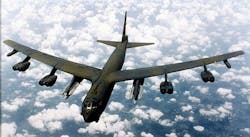Air Force moves forward on upgrading situational-awareness tactical data links on B-52 bomber fleet
Officials of the Air Force Life Cycle Management Center (AFLCMC) at Wright-Patterson Air Force Base, Ohio, released a sources-sought notice (FA862815RB52CONECT) last week for the B-52 Combat Network Communications Technology (CONECT) Production Program.
The Boeing-developed CONECT avionics upgrade adds to the B-52 several communication data links, full-color liquid crystal displays with real-time intelligence feeds overlaid on moving maps, a modern computing network, and the ability to retarget a weapon, or mission parameters, in flight.
Air Force officials are trying to determine if any companies are qualified to provide all personnel, equipment, facilities, supplies, services, materials, and management necessary for the production and delivery of CONECT upgrade kits.
Related: Air Force considering AESA radar upgrades for B-1 and B-52 strategic bomber fleets
Based on responses, Air Force officials say they issue a formal solicitation early next year for a five-year contract to produce CONECT upgrade kits.
Air Force officials are looking for companies able to perform several tasks involved in producing CONECT upgrade kits. Tasks include providing 46 B-52 CONECT modification kits, spares, readiness spare packages, and support equipment.
Included in the CONECT modification kits are six units of peculiar support equipment; 14 CONECT mission support system ground stations; 114 removable storage devices; and technical support for installation of the CONECT system on the B-52H aircraft -- including with parts and components expected to go obsolete and depot maintenance during the program.
This effort is in support of CONECT full-rate production program, now performed by the Boeing Co. Defense, Space & Security segment in St. Louis. Companies responding must have in-depth knowledge of the B-52 aircraft and the B-52 CONECT system.
Related: New teeth for an old dog: Air Force seeks to give a bigger bite to B-52H bomber firepower
The B-52 CONECT program involves new computers and color displays, key data links, an advanced wideband satellite terminal, and tie-ins to existing Air Force systems to enable B-52s to receive new missions and re-target weapons during flight.
The Air Force began introducing CONECT technology to the B-52 fleet last May to add several communication data links, color displays with real-time intelligence feeds overlaid on moving maps, a new computing network.
Boeing delivered the first CONECT-equipped B-52 to Barksdale Air Force Base, La., last May as part of the CONECT low-rate initial production contract. Boeing is supporting the Air Force’s installation of the first CONECT kits at Tinker Air Force Base, Okla.
Related: Boeing B-52 upgraded with CONECT system makes first test flight
The Air Force operates 76 B-52s primarily out of Barksdale Air Force Base, La.; Minot Air Force Base, N.D.; and Andersen Air Base, Guam.
Companies whose officials would like to put their names forward as candidates for the B-52 CONECT production program should email 10-page papers outlining their qualifications no later than 22 Sept. 2014 to the Air Force's Curtis Thatcher at [email protected].
For questions or concerns contact Thatcher by phone at 937-713-7593 or by email at [email protected]. More information is online at https://www.fbo.gov/spg/USAF/AFMC/ASC/FA862815RB52CONECT/listing.html.
